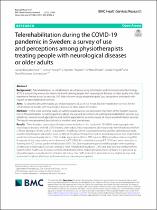| dc.contributor.author | Bezuidenhout, Lucian | |
| dc.contributor.author | Joseph, Conran | |
| dc.contributor.author | Thurston, Charlotte | |
| dc.date.accessioned | 2022-05-11T13:17:30Z | |
| dc.date.available | 2022-05-11T13:17:30Z | |
| dc.date.issued | 2022 | |
| dc.identifier.citation | References Adebiyi, B. O., Goldschmidt, T., Benjamin, F., Sonn, I. K., Rich, E., & Roman, N. V. (2022). Enablers and barriers to effective parenting within the first 1000 days: An exploratory study of south african parents and primary caregivers in low socio-economic communities. BMC Public Health, 22(1) doi:10.1186/s12889-022-13179-9 | en_US |
| dc.identifier.uri | doi:10.1186/s12889-022-13179-9 | |
| dc.identifier.uri | http://hdl.handle.net/10566/7379 | |
| dc.description.abstract | Background : Telerehabilitation, i.e. rehabilitation at a distance using Information and Communication Technology
(ICT), is a promising avenue for improving health among people with neurological diseases or older adults who often
experience limited access to services. Still, little is known about physiotherapists’ use, perceptions and needs with
regards to telerehabilitation services.
Aims: To describe physiotherapists use and perceptions of, as well as needs for, telerehabilitation services for the
rehabilitation of people with neurological diseases or older adults in Sweden.
Methods: In this cross-sectional study, an author-created survey was sent out to members of the Swedish Association of Physiotherapists including questions about the use and perceptions of existing telerehabilitation services (e.g.
telephone, internet-based applications and mobile applications) as well as needs of future telerehabilitation services.
The results were presented descriptively as numbers and percentages.
Results: Three hundred seven physiotherapists were included in this study with 139 (45%) treating people with
neurological diseases and 168 (55%) treating older adults. Most respondents did not provide telerehabilitation before
(74%) or during (51%) the COVID-19 pandemic. Telephone, which was predominantly used for administrative tasks,
was the most frequent utilised ICT used by 68% of the physiotherapist using ICTs several days/week. Few respondents
used internet-based applications (12%), mobile applications (3%) or SMS services (8%) and videoconferencing (3%).
A majority of the respondents were interested in ICT (78%), felt comfortable using ICT (57%) and were interested in
learning how ICT can be used in rehabilitation (92%). Still, few respondents perceived that people with neurological diseases or older adults can use existing ICTs for rehabilitation purposes (18%) and that existing reimbursement
system within health care facilitates remote rehabilitation (16%). Important functionality of future ICT perceived by
physiotherapists covered patient communication (e.g. chat, SMS and video), assessments (e.g. digital surveys and
assessment of physical activity) and treatment (e.g. exercise prescription). | en_US |
| dc.language.iso | en | en_US |
| dc.subject | Telerehabilitation | en_US |
| dc.subject | Information and Communication Technology (ICT) | en_US |
| dc.subject | Neurological diseases | en_US |
| dc.subject | Physiotherapists | en_US |
| dc.title | Telerehabilitation during the COVID-19 pandemic in Sweden: a survey of use and perceptions among physiotherapists treating people with neurological diseases or older adults | en_US |
| dc.type | Article | en_US |

